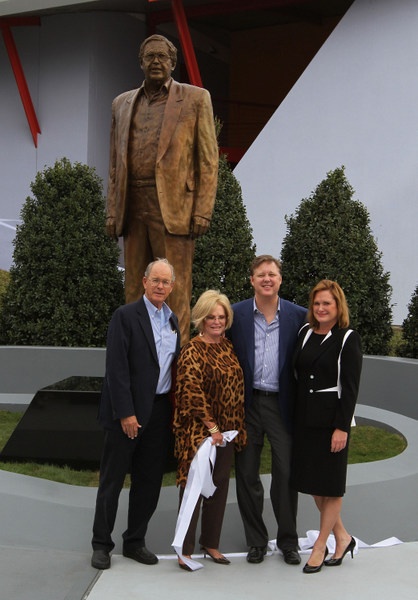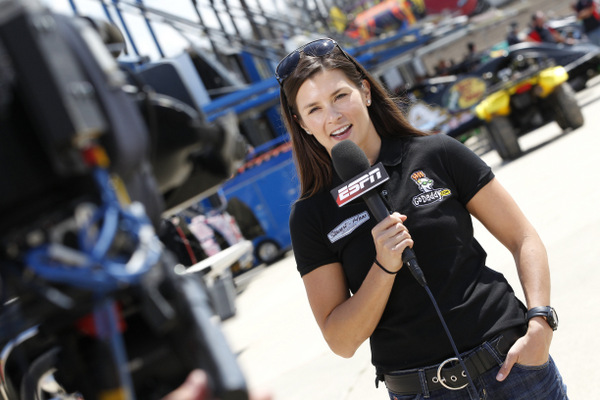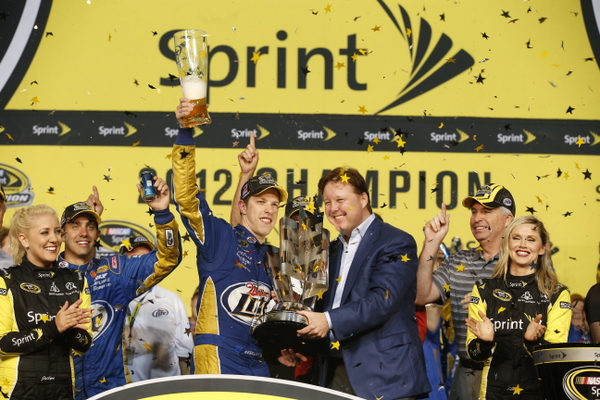Daytona Rising....and how best to recreate those sellout stock car racing crowds?

The power brokers, Jim France (L), Betty Jane France, Brian France, Lesa France Kennedy (Photo: Getty Images for NASCAR)
(Updated)
By Mike Mulhern
mikemulhern.net
DAYTONA BEACH, Fla.
The state of the France family empire, on the hardware side -- seats and such -- is looking pretty darned good, according to Wednesday's quarterly report to Wall Street investors.
The hot questions were about the pending new TV contracts, about which officials had little to say, except that some answers could be coming near the end of the year.
The hot promotion officials want to talk about is the multi-million-dollar facelift this flagship track is about to undergo. Executives for the International Speedway Corp (NASDAQ: ISCA) reckon this economic turnaround the country is now feeling should be a fair wind for their big project.
Brian France, the NASCAR boss, and brother of ISC boss Lesa France Kennedy, was just on Jim Cramer's CNBC show the other evening, proudly talking about the new report that 25 percent of the companies in the Fortune 500 are now marketing in this sport.
With all this good news, how are those television negotiations going, on those new contracts?
Well, NBC is quite interested in picking up a piece of stock car racing.
Fox has already renewed for another eight years.
ESPN says it considers NASCAR a must-have.
No wonder ISC officials say they're "fairly optimistic" about the new TV deals looming.
Fox' first half of the season was essentially flat, compared to its 2012 season. But Fox says it sees strength in the 18-49 male demographic.
Soooo how much money can this sport figure to take from the TV pie?
There were worries, when ratings kept declining, that the sport might have to settle for less money than in the current contracts.
However Fox jumped in quickly with a 30 percent increase in its price point, and ISC men are now figuring the total new TV contract packages could provide an overall increase of at least 25 percent, which would be amazing.
Another part of the money picture, of course, is ticket sales. And crowds really haven't been great the past two seasons at most tour tracks. The last time a NASCAR track boasted a sellout was when?
So ISC people are working on a new game plan -- reduce seats.
The February Phoenix race, the March California race, and the April Martinsville race all featured 'Chamber of Commerce' weather. And that was great for the walk-up crowd, which has become a key part of the ticket story.
Bad weather, and bad forecasts, like for the Talladega 500, can kill the walk-up crowd. Talladega's advance ticket sales for the May 500 were down 23 percent.
The frigid weather for the Kansas race didn't help, though officials say the crowd was 'encouraging.' The Kansas track features the Hollywood Casino, which is expected to generate some $20 million in profit.
Richmond, on the other hand, didn't do as well as expected. The missing fans, it appears, are not long-distance fans but rather fans from the greater Richmond area. And average ticket prices were down.
ISC executives call it something of a "quagmire," and say to fix the basic issue, this sport has to cut seating. There are too many tracks with too many seats. That hurts in more ways than one.
So ISC plans to seriously cut seating 'inventory.' Here that's by eliminating the backstretch 'SuperStretch.'
Now NASCAR's Sprint Cup crowds, from 50,000 to 90,000, are not bad crowds by any means....only a lot smaller than during the boom times of the late 1990s and early 2000s.
This new Daytona project, dubbed Daytona Rising, by marketers, could get some 'public incentives,' like other big time sports get, if ISC officials can work things out with state officials. The first attempt at that didn't get far. But ISC men say they're not giving up.
The 'new' Daytona includes widening 18-seats to 20 inches or more. When completed, this track would have only 101,000 seats, instead of the 168,000. Also included, a major upgrade in restrooms; currently restrooms here have 812 fixtures, and the new plan would increase that to nearly 1,900.
Reducing seating could help track promoters in two ways.
First, by creating what ISC people are calling 'a sense of urgency' about buying tickets, to get fans to buy earlier....reducing the effects of forecasts of bad weather.
Second, by taking the sport back to the days when fans had to buy a Saturday ticket too to be able to buy a ticket to Sunday's Cup race; that would help pump up crowds for the Nationwide and Truck series.
ISC men says the sooner this sport can start selling out Cup events again, the easier it will be to promote Nationwide and Truck.
Brian France and Brad Keselowski celebrating the championship (Photo: Getty Images for NASCAR)
Meanwhile, on the Bruton Smith/Marcus Smith front, the second quarter results aren't in yet (for April/May/June). That should be a big report, because it includes the Texas, Charlotte and Sonoma races.
The Smiths' Speedway Motorsports report (NYSE: TRK) for the first quarter was issued May 1st, covering events at Las Vegas and Bristol. Revenue was off from the 2012 quarter, with a loss of $1.3 million, on total revenues of $84.2 million. The company called that "within expectations," and issued the warning that "until the US begins experiencing consistent economic recovery across all markets, our attendance and revenue streams will continue to be impacted."
Weather was an issue at Bristol.
TRK says ticket sales for those two NASCAR weekends was down $713,000 from 2012, adding that was because attendance was down. The company also noted that the cost of NASCAR sanctioning fees for those two events was up $531,000 from last year.
The big picture: Speedway Motorsports' total annual revenue for 2012 was $490 million, down considerably from the banner 2008 season, which had revenues of $611 million. (A key item in revenues, TV money, figured to be nearly $200 million this year for TRK tracks.)
Nevertheless Speedway Motorsports executives did reaffirm guidance for the full year, saying they expected to earn from $.90 to $1.20 a share.
Demographics are a crucial part of the game plan for both ISC and TRK.
However it's not entirely clear that all the power brokers in this sport have a good understanding of the demographic issues at hand, or how to deal with them.
How well the diversity programs are working is one point.
And the Danica Patrick marketing program, which has apparently worked well in some respects, may have run its effective course (though that isn't keeping NASCAR marketers from continuing to push the oversell).
Speedway Motorsports officials, in their May report, said they believe part of the decline in attendance the past few years "can be attributed to that changing demographic." They went on to say they were making investment "in new marketing approaches and leading-edge technology, to foster attendance by families, particularly those with younger children and teenagers."

It's all about demographics, apparently. Maybe someone should also be keeping an eye on what's happening -- and not happening -- out on the track too (Photo: Getty Images for NASCAR)
© 2010-2011 www.mikemulhern.net All rights reserved.
Web site by www.webdesigncarolinas.com








Post new comment